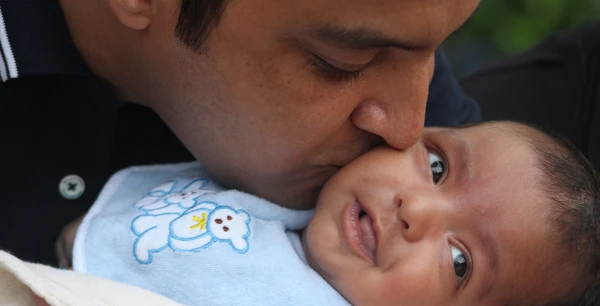Navigating your 2-month-old’s sleep can feel like a rollercoaster—some nights are smoother, while others feel completely unpredictable. That’s because, at this age, your baby is still adjusting to life outside the womb and doesn’t yet have a fully developed internal sleep clock.
The good news? With gentle guidance and consistent routines, you can begin laying the foundation for healthy sleep habits. There’s no need for a rigid schedule just yet—at this stage, it’s all about observing your baby’s sleep cues, ensuring they get enough rest, and slowly introducing comforting bedtime routines.
Let’s dive into what you can expect at this age and how to gently guide your little one toward more restful sleep.

Understanding 2-Month-Old Sleep Patterns
At two months, your baby is becoming more alert and interactive during wake times. You might notice your little one smiling, tracking objects, and making adorable cooing noises. But sleep is still very immature, and it’s completely normal for their patterns to feel unpredictable.
At this age, babies typically need around 14–17 hours of total sleep per day, including:
Daytime sleep: 5–6 hours, spread over 4–5 naps.
Nighttime sleep: Around 10–12 hours (with wakings for feeding).
Most 2-month-olds still wake every 3–4 hours overnight to eat, and that’s okay! Their little stomachs are still small, and they’re learning to stretch their sleep gradually.
Parent Tip: If your baby still seems to have their days and nights reversed, try keeping daytime naps well-lit and engaging while keeping nighttime wake-ups calm and quiet.
Safe Sleep Practices for a 2-Month-Old
Creating a safe sleep environment is crucial at this stage. Here are the key sleep safety guidelines:
- Always place your baby on their back for sleep, every time.
- Use a firm crib mattress with a snug-fitted sheet—no pillows, blankets, or stuffed animals.
- Room-share, but don’t bed-share (the AAP recommends keeping baby’s crib or bassinet in your room for at least six months).
- Keep the sleep space clear—no bumpers, loose bedding, or toys.
- Maintain a comfortable room temperature (68–72°F) and dress your baby in light layers to prevent overheating.
- Offer a pacifier for sleep—it may reduce the risk of SIDS (but don’t force it if your baby isn’t interested).
A safe sleep space helps your baby rest comfortably and securely.

Sample 2-Month-Old Sleep Schedule
Every baby is different, but here’s a flexible example of what your baby’s day might look like:
| Time | Activity |
|---|---|
| 7:00 AM | Wake up & feed |
| 8:15 AM | Nap 1 (45 min – 1.5 hrs) |
| 9:30 AM | Awake & feed |
| 10:45 AM | Nap 2 (1–1.5 hrs) |
| 12:00 PM | Awake & feed |
| 1:15 PM | Nap 3 (1–2 hrs) |
| 3:00 PM | Awake & feed |
| 4:30 PM | Nap 4 (30–45 min) |
| 5:15 PM | Awake & short playtime |
| 6:45 PM | Short catnap (30 min) |
| 7:30 PM | Awake, feed, and start bedtime routine |
| 8:00 PM | Bedtime |
| 10:30 PM | Dream feed (optional) |
Nighttime wakings: Most babies wake 2–3 times overnight for feedings.
Remember: Some days will look different—and that’s okay! The goal is flexibility with gentle consistency.
Recognizing Sleep Cues & Preventing Overtiredness
Babies this young can’t follow a clock, so the best way to time naps is by watching their sleep cues:
Signs your baby is ready for sleep:
- Yawning or rubbing eyes.
- Fussing or sudden crankiness.
- Looking away from stimulation (toys, faces).
- Slow, drowsy blinking.
Putting your baby down at the right time (before they’re overtired) makes falling asleep easier.
Why Is My 2-Month-Old Taking Short Naps?
It’s completely normal for naps to be short (30–45 minutes) at this age. That’s because their sleep cycles are still developing!
To encourage longer naps:
Create a consistent nap environment (dark room, white noise).
Try soothing techniques (rocking, patting) if they wake too soon.
Give them a few minutes to resettle before intervening.
If naps are consistently short, don’t worry—this improves as your baby matures.
FAQs
1. My Baby Sleeps a Lot—Should I Be Concerned?
If your baby is eating well and gaining weight, extra sleep is usually fine. But if they seem difficult to wake or are missing feedings, check with your pediatrician.
2. My Baby Wakes Up Every Hour at Night!
At this age, it’s normal for babies to wake frequently for feedings. However, if they’re waking every hour:
Try adjusting wake windows (too short or too long can cause frequent waking).
Make sure your baby is getting enough daytime feedings.
Focus on putting them down drowsy but awake so they practice self-settling.
3. My Baby Sleeps More During the Day Than at Night.
If your baby still has day/night confusion, try:
Keeping naps well-lit and active during the day.
Keeping nighttime wake-ups calm and quiet (dim lights, soft voices).
Final Thoughts: Gentle Steps Toward Better Sleep
At two months, your baby’s sleep will still fluctuate, and that’s completely normal! The most important things to focus on are:
Observing sleep cues and keeping wake windows short.
Gently introducing bedtime routines to signal sleep time.Creating a safe, cozy sleep environment that promotes rest.
Most importantly, be patient with yourself and your baby. Sleep at this stage is a journey, and small, consistent steps will help your little one build healthy sleep habits over time.
Citations
- CDC, “Important Milestones: Your Baby by Two Months,” Centers for Disease Control and Prevention, 2023, https://www.cdc.gov/ncbddd/actearly/milestones/milestones-2mo.html.
- M. Hirshkowitz, M. Hirshkowitz, Kaitlyn Whiton, S. Albert, C. Alessi, O. Bruni, L. Doncarlos, Nancy L Hazen, J. Herman, E. Katz, L. Kheirandish-Gozal, D. Neubauer, A. O’donnell, M. Ohayon, J. Peever, R. Rawding, R. Sachdeva, B. Setters, MICHAEL V. Vitiello, J. Ware and P. Hillard. “National Sleep Foundation’s sleep time duration recommendations: methodology and results summary..” Sleep health, 1 1 (2015): 40-43 . https://doi.org/10.1016/j.sleh.2014.12.010.
- J. Mindell, A. Li, A. Sadeh, R. Kwon and D. Y. Goh. “Bedtime routines for young children: a dose-dependent association with sleep outcomes..” Sleep, 38 5 (2015): 717-22 . https://doi.org/10.5665/sleep.4662.
- Reddy S, Reddy V, Sharma S. Physiology, Circadian Rhythm. [Updated 2023 May 1]. In: StatPearls [Internet]. Treasure Island (FL): StatPearls Publishing; 2024 Jan-. Available from: https://www.ncbi.nlm.nih.gov/books/NBK519507/
- P. Devnani. “Paediatric sleep medicine.” The Indian Journal of Sleep Medicine, 5 (2010): 105-110. https://doi.org/10.5005/IJSM-5-4-105.
- Liu, Z., Guo, Y., Song, J., Zou, L., & Ma, L. (2022). Sleep initiation patterns and their influence on sleep quality in infants and young children.. Zhongguo dang dai er ke za zhi = Chinese journal of contemporary pediatrics, 24 3, 297-302 . https://doi.org/10.7499/j.issn.1008-8830.2111004.
- MedlinePlus. “Bedtime Habits for Infants and Children.” MedlinePlus Medical Encyclopedia, October 21, 2022. https://medlineplus.gov/ency/article/002392.htm.
- Adams, E., Savage, J., Master, L., & Buxton, O. (2020). Time for bed! Earlier sleep onset is associated with longer nighttime sleep duration during infancy.. Sleep medicine, 73, 238-245 . https://doi.org/10.1016/j.sleep.2020.07.003.
- American Academy of Pediatrics, “Preemie Sleep Patterns,” HealthyChildren.org, November 21, 2015, https://www.healthychildren.org/English/ages-stages/baby/preemie/Pages/Preemie-Sleep-Patterns.aspx.
- AAP TASK FORCE ON SUDDEN INFANT DEATH SYNDROME. “SIDS and Other Sleep-Related Infant Deaths: Updated 2016 Recommendations for a Safe Infant Sleeping Environment.” Pediatrics, 138 (2016). https://doi.org/10.1542/peds.2016-2938.
- Bathory E., Tomopoulos S. Sleep Regulation, Physiology and Development, Sleep Duration and Patterns, and Sleep Hygiene in Infants, Toddlers, and Preschool-Age Children (2017) Current Problems in Pediatric and Adolescent Health Care, 47 (2), pp. 29-42. https://doi.org/10.1016/j.cppeds.2016.12.001




